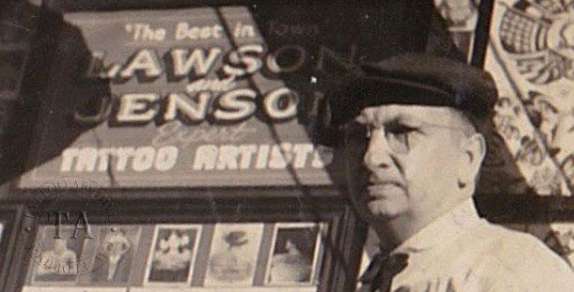Owen Jensen
In the early 20th century to be a tattoo artist meant that you had an understanding for the mechanical as well as the artistic application of tattoos. You’ll start to notice that theme amongst the artists we focus on. A tattooist in 1920 was responsible for the maintenance, modifications, and sometimes complete construction of their own machines, needles, pigments and any other tool used for the craft. On top of that they were creating their own design catalogs known as flash. They were constantly on the lookout for new designs to entice customers. Some tattooists had more natural ability as artists than others. The most successful tattooists of the time were masters of both technical and artistic approach.
Legendary American tattooer Owen Jensen was born in 1891 in Pleasant Grove Utah. As a young man, Jensen found work on the railroad, but there was more out there for this fella. It is said that Jensen hiked 12 miles to get to the “Buffalo Bills Wild West Show” where he was captivated by what he saw; The tattooed man known as James Malcom. From that day forward, Jensen decided that tattoos were the “cats pajamas” and his life would be affected in many ways by tattoos. He received his first ever tattoo in 1913 from a well-known tattooer of the era, Bob Hodge, on the Lucky Bill Show, a wild west performance that attracted large crowds. In the early 1900’s leading up to WWI and the Great Depression tattooers operated very largely out of circus sideshow tents. At the time there were very few artists with storefronts. They were mostly in port cities and seedy parts of town, such as New York’s Bowery district.
Before his career in tattooing, Jensen Worked at the Ford Motor Company as a machinist and got a part time job building tattoo machines because of his fine skills. Jensen then became even more interested in tattooing.
Like most young men of the time, Jensen enlisted in WWI where after his time oversees, he was stationed in Grand Rapids Michigan. Jensen tattooed some of his fellow soldiers while he was in the military, but it is unknown who taught him how to tattoo. Jesen eventually met Edwin Brown who was a very well-known tattooer of that region. He taught Jensen how to paint flash, and this made Jensen even more enthusiastic to begin his journey into the amazing world of tattooing.
Bit by the bug, Jensen headed back home to Utah and built himself a trunk, loaded it up, and made his way across the country, traveling with side shows tattooing all along the way. In 1923 he headed to the west coast working in an arcade in LA with Jack Julian and later a pool hall in San Pedro for several years tattooing the Naval fleet. Building his skills all the while, he was given the opportunity to work for Charlie Barr, who was considered one of the best of the time.
In 1934, Jensen began building his own tattoo machines and selling them up and down the boardwalk. Like fire, the word spread and soon Jensen was running the largest tattoo supply company on the West Coast. He offered some of the best machines available and high-quality designs. Because most tattooists of the time were less artistically inclined good designs were highly prized and guarded.
A traveling man, Jensen ended up working with many of the great tattooists of the day including Cap Coleman, Lee Roy Minugh, Bert Grimm, Paul Rogers, and a special woman known as Dainty Dotty. Jensen met Dotty in Detroit where they fell in love both with each other and tattooing. Florence H “Dainty Dotty” Sprague Jensen was a former Fat Lady Circus performer for Ringling Bros. An insulting and degrading career, Dotty moved on to bigger and better things
She and Jensen were married in 1945, and they headed back to LA. Here they made a life together, tattooing in Long Beach on the Pike, eventually becoming parents and having a baby boy. Three years after their son was born, Dotty fell ill and died of a heart ailment. Crushed by losing his true love and having to raise a child by himself, Jensen decided to close the supply business and solely focus on tattooing and his boy. He began working with Bert Grimm at his Shop on the Long Beach boardwalk Known as the NU-Pike. After a falling out with Grimm he moved down the boardwalk to work for Lee Roy Minugh. Jensen was enthralled with tattooing up till the very end, working the late shift at Lee Roy’s as an 80-year-old man.
Over the years the Nu-Pike grew more violent, and crime intensified. Jensen was no idiot and carried a pistol on him for protection. One ill- fated night in 1976, Jensen was working the late shift and was surprised by two reprehensible bastards who were looking for some quick cash. Jensen couldn’t get to his pistol fast enough and was stabbed and left to die. They got away with only $30. Owen Jenson hung on for a year until he succumbed to his injuries and passed away on July 24,1977. He died at the age of 85 and tattooed up until that terrible night.
Although he met his fate on that tragic night he will always be regarded as one of tattooing’s great innovators and pioneers. Without the great tattooists of the era such as Jensen we would not have the tattoo world we know today.


